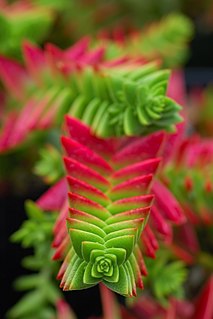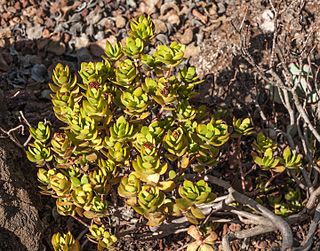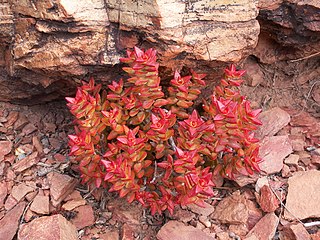
Crassula is a genus of succulent plants containing about 200 accepted species, including the popular jade plant. They are members of the stonecrop family (Crassulaceae) and are native to many parts of the globe, but cultivated varieties originate almost exclusively from species from the Eastern Cape of South Africa.

Dombeya is a flowering plant genus. Traditionally included in the family Sterculiaceae, it is included in the expanded Malvaceae in the APG and most subsequent systematics. These plants are known by a number of vernacular names which sometimes, misleadingly, allude to the superficial similarity of flowering Dombeya to pears or hydrangeas. Therefore, the genus as a whole is often simply called dombeyas. The generic name commemorates Joseph Dombey (1742–1794), a French botanist and explorer in South America, involved in the notorious "Dombey affair", embroiling scientists and governments of France, Spain, and Britain for more than two years.

Aeschynomene is a genus of flowering plants in the family Fabaceae, and was recently assigned to the informal monophyletic Dalbergia clade of the Dalbergieae. They are known commonly as jointvetches. These legumes are most common in warm regions and many species are aquatic. The genus as currently circumscribed is paraphyletic and it has been suggested that the subgenus Ochopodium be elevated to a new genus within the Dalbergieae, though other changes will also be required to render the genus monophyletic.

Crassula tetragona is a succulent plant native to Southern Africa. It is widely distributed from the Orange River boundary of Namaqualand to beyond the Kei River in the Eastern Cape. "Tetragona" comes from the phyllotaxy of the leaves. It is popularly named the "miniature pine tree" among ornamental plant enthusiasts, for its popular use as a "pine tree" in Bonsai.
Crassula colorata, the dense pigmyweed or dense stonecrop, is an annual plant in the family Crassulaceae. The species is endemic to Australia, occurring in Western Australia, South Australia, New South Wales and Victoria.

Cotyledon tomentosa is a species of flowering plant in the family Crassulaceae, native to South Africa. It is a succulent evergreen shrub with large chunky ovate fuzzy green leaves. Its autonymous subspecies is known as the bear's paw because of the prominent "teeth" at the tips of its leaves. It forms large orange bell-shaped flowers in spring. In its native habitat, the Little Karoo region of South Africa, cotyledons usually grow in rocky quartz fields where they have excellent drainage provided by very porous soil.

Calochortus elegans is a species of flowering plant in the lily family known by the common name elegant Mariposa lily, cat's ear, elegant cat's ears or star tulip. It is native to the western United States from northern California to Montana.

Crassula marnierana, common name Jade Necklace or Chinese Pagoda, is a species of succulent in the genus Crassula belonging to the family Crassulaceae.
Cyperus elegans, the royal flatsedge, is a sedge species in the genus Cyperus from Central and South America.
Hellmut R. Toelken is a South Australian botanist. He retired in December 2008 from the position of senior biologist at the State Herbarium of South Australia, but remains an honorary research associate. Earlier he was with the Botanical Research Institute, Department of Agricultural Technical Services, Pretoria, S Africa.

Xerophyta elegans is a species of plants in the family Velloziaceae. It is endemic to South Africa and its natural distribution and habitat is restricted to Drakensberg Mountains in Mpumalanga province. The plant is evergreen and similar to other members of its family it is able to express high level or tolerance against desiccation and even long treatment with sulphuric acid under dry conditions leaves it able to revive and restart its photosynthetic abilities. Talbotia produces narrow but long, leathery leaves and white star-shaped flowers with yellow stamens. The seeds are hooked thus enhancing dispersal by animals.

Crassula brevifolia is a succulent plant native to the arid western edge of South Africa as well as southern Namibia.

Crassula cultrata is a succulent plant native to the southern parts of South Africa.

Crassula pubescens is a succulent plant, common and widespread in the southern Karoo regions of South Africa.

Crassula perfoliata is the type species of the nominative genus, Crassula, of the family Crassulaceae, where it is placed in the subfamily Crassuloideae. It was first formally described by Linnaeus in 1753 as one of 10 species of Crassula. It is a perennial, from S Africa.

Crassula rupestris, called buttons on a string, is a species of Crassula native to the Cape Provinces of South Africa. It has gained the Royal Horticultural Society's Award of Garden Merit. It is also called bead vine, necklace vine, and rosary vine.













